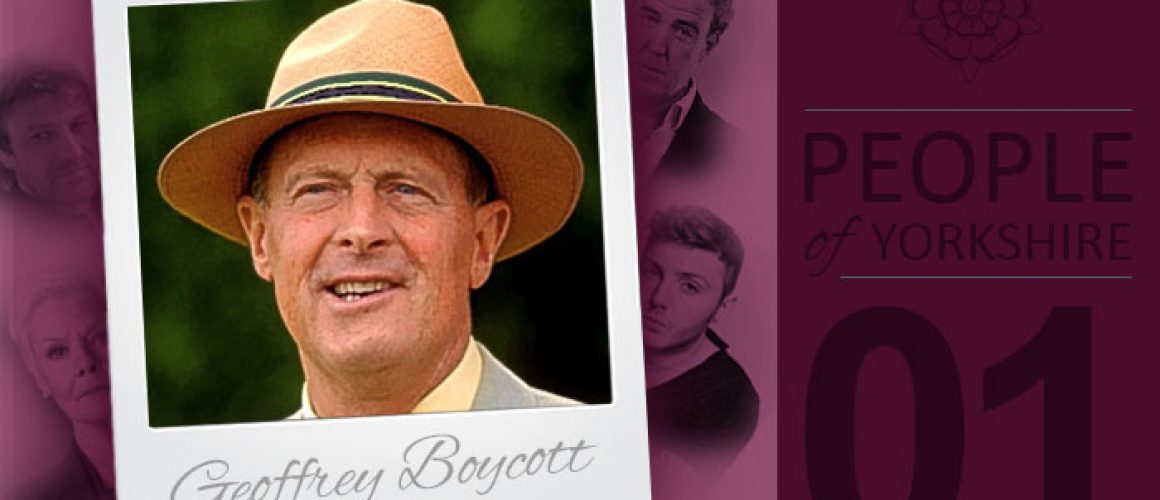Geoffrey Boycott – Life, Career & Where He is Now
When first thinking of people who are born and bred in Yorkshire, one of the very first names that spring to mind is Geoffrey Boycott. A man who is both a cricket legend and renowned broadcaster.
Geoffrey Boycott is known for his gritty batting style along with his forthright views, which are sometimes controversial, on the sport that epitomises the county of his birth.
Page Contents:
- Growing Up
- Debut in the County Championship
- Maiden Test for England
- Boycott’s Finest Hours
- Yorkshire’s Captain
- Returning to Cricket
- Conflict
- Boycott’s Incredible Career
- What is Geoffrey Boycott doing Now?
Growing Up
The cricketing legend Geoffrey Boycott was born on the 21st of October in 1940 in the village of Fitzwilliam. He was the oldest son of Jane and Thomas Boycott and had two younger brothers. The village of Fitzwilliam lies halfway between the city of Wakefield and the town of Doncaster.
Thomas Boycott, Geoffrey’s dad, who worked as a miner. In 1950, Thomas suffered spinal damage after he was caught between two empty coal carts. 17 years later, Thomas died.
When Boycott was only 8, he was playing on an iron railing close to his home and ended up falling off of it. Boycott ended up impaled through his chest by the handle of a mangle and as a result, in order to save his life, had to have his spleen removed.
Boycott attended his local primary school, Fitzwilliam Primary School, and soon shone on the cricket field. In one school cricket match, he took five wickets and scored 45 runs which won him the Len Hutton Batting Award.
Receiving this award further encouraged Geoffrey in his passion for cricket. As a result, he decided to join the Ackworth Cricket Club where people soon saw him as an exciting new talent.
When Boycott had completed his education at Hemsworth Grammar School, he decided to pursue his love of cricket and make a career out of it. He was soon playing for Barnsley Cricket Club alongside Dickie Bird and Michael Parkinson.
It was here that Boycott soon became noted for his intense power of self-belief, concentration, and technique by Clifford Hesketh. Clifford was part of the Yorkshire Cricket Club Committee.

In 1959, had a career breakthrough and was invited to play for the Yorkshire Second XL. In three years, he had topped the averages for any teams that he turned out for which included Leeds CC and the Yorkshire Colts.
Ultimately, it was only a matter of time before Boycott was given an opportunity in the Yorkshire First team. This came in June 1962 against the touring Pakistani team where he scored four in both innings.
Debut in the County Championship
A debut in the County Championship soon followed against Northamptonshire. However, Boycott suffered a series of low scores in his inaugural season which led many at the club to wonder whether he was good enough to play at first class level.
Soon after people started doubting Boycott, he started putting more in more effort which led to his eventual success. Along with lots of practice and hard work, Boycott decided to switch from wearing glasses to contact lenses.
Another change for Boycott was a change in the Yorkshire Captaincy. This saw Vic Wilson replaced by Brian Close as the captain of the Yorkshire cricket team.
Brian Close saw the potential in Boycott and managed to persuade the Yorkshire committee to keep faith in the young prodigy. In June 1963, Boycott repaid this support when he scored 145 runs in the Roses match against Lancashire.
Boycott shared a record breaking 249 run stand for the fourth wicket in the process. As a result, this cemented his place in the side that season with several important contributions throughout.
One of these included 165 runs against Leicestershire. Boycott ended his first full season with an impressive score of 1,146 runs with an average of 46.64.
Maiden Test for England
It wasn’t long before Boycott’s country came calling for him. In 1964, he played his maiden test for England in that years’ home Ashes series. This ended with Boycott scoring a total of 291 runs throughout the series. He also finished his maiden test at The Oval.
Boycott was a right-handed opening batsman. As a result, he was often criticised for his slow scoring rate and perceived as having a tendency to bat for himself rather than for the good of the team.
Geoffrey achieved his highest test discord of 246 in front of his home crowd at Headingley. Despite this, he was sensationally dropped for the next test as it was deemed that he had taken too long to compile his innings.
During this time, it had allegedly taken the whole of the first day’s play to make 106 runs. In the process half of the Headingley crowd, along with those sitting in the press box, went to sleep.
On the second day, another tactic was used. It was based more on attacking and Boycott had managed to hit 140 runs in four hours. Despite England’s subsequent victory by six wickets, the knives were out for the belligerent Yorkshireman.
Geoffrey Boycott returned to the fold for the final test of the series at Edgbaston. He was then selected for the winter’s tour to the Caribbean.
Boycott’s Finest Hours
One Of Boycott’s finest hours for the White Rose came in 1965 at the Gillette Cup Final at Lords. His blazing 146 not out against Surrey paved the way for a comprehensive 175 run victory.
Boycott had hit three sizes and fifteen fours. This showed that he could bat freely when the situation allowed.
Yorkshire’s Captain
In 1971, Boycott was made Yorkshire’s captain however this proved to be an unpopular decision among some of the other cricket players. Despite this, Boycott’s personal batting form and average went from strength to strength. He was regularly averaging over 60 runs per cricket match.
On the other hand, despite Boycott’s success, the team as a whole were failing to perform. Over time, they began to slump lower and lower in the County Championship as the 70’s wore on. In 1978, things came to a head when several committee members and players began to speak out about their declining form.
From 1974 to 1977, Boycott had concentrated solely on captaining his beloved country. He decided to place himself in a self-imposed exile from England duties and said he had a loss of appetite for test cricket.
However, in the summer of 1977, Boycott returned for the home Ashes series. It was during this time that a young Ian Botham decided to make his debut.
In the fourth test at Headingley, Boycott was at the centre of one of the most famous cricketing moments. He hit his 100th century in first class cricket and was the first to achieve this feat in a test match.
On this occasion, the fact it had taken him five hours to do it was briefly forgotten. The Yorkshire cricketing public and even the Southern press were once again adoring fans.
Returning to Cricket
In September 1978, it was decided that John Hampshire should take on the captaincy permanently. After much thought, Boycott returned as a normal player in the following 1979 season.
During this time, he broke several county records. This included the most number of centuries for the county of 129 previously set by Len Hutton and finished the following season with an average of over 50 runs for the 11th year running.
Boycott briefly captained his country on a winter tour to New Zealand but eventually passed the reins to Ian Botham. The two, however, would combine more positively in the famous 1981 series.
This happened when a stubborn partnership happened between Boycott and Peter Willey. During the second innings at Leeds, foundations were laid for Botham and Willey’s subsequent fireworks with bat and ball. In the end they won the match for England against the odds.
This famous Ashes series saw Boycott become England’s leading run scorer during the 6th test at The Oval at the age of 40. The winter tour to India would be his last. During this time, he passed Gary Sobers’ record of becoming the highest ever run scorer in test matches.
Conflict
In 1983, Boycott was still playing for his home county. Having been stripped of the captaincy, five years previously he came into conflict with other cricket players and members of the committee.
This friction eventually led to the committee refusing to offer Boycott a new contract. Two factions at the cricket club emerged, those in favour of reinstating their most famous son, and those who wanted rid of him.
In 1984, Boycott was offered a new contract. This prompted the resignation of several Yorkshire CC members, most notably fellow legend Fred Trueman, and he continued playing for another two years.
By now, Boycott was 46. The emergence of new younger players such as Phil Robinson and Martyn Mxon meant that he hung up his cricket whites for the last time in September 1986.
After 24 years at the top of the game, he scored a total of 32,570 runs for Yorkshirre with a batting average of 57.86. For England he amassed 8114 test match runs at an average of 47.72.
Boycott’s Incredible Career
Boycott’s entire career stretched from 1962 to 1986. In total, he played 108 test matches for England and made 609 first class appearances for Yorkshire.
Between 1971 and 1978, Boycott was the captain of the Yorkshire Cricket Club. He became the then highest test match run scorer for England and scored 100 centuries in first class cricket.
What is Geoffrey Boycott doing now?
Boycott has continued his life as a well-known and opinionated commentator on Sky, Channels four and five plus BBC Test match Special. His familiar Yorkshire accent and blunt appraisals of a sometimes failing modern England team are a constant feature of an English summer.
In 2002, Boycott was diagnosed with throat cancer. He underwent radiation treatment that proved successful and has been in remission since 2003.
Seven years later, he was inducted into the Cricketing Hall of Fame. Boycott has continued to have a strong influence on his home county and was elected president of the club in 2012, until he was replaced by Dickie Bird in February 2014. In 2020, Boycott officially retired.
Geoffrey Boycott is a true Yorkshire legend, who was never afraid to stick to his own beliefs and who has helped retain Yorkshire’s presence on the cricketing map both in this country and throughout the world.

